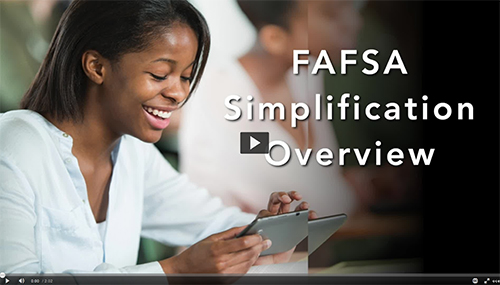FAFSA Simplification
The 2025-2026 FAFSA is Changing!
Simplifying the financial aid application process: the FAFSA Simplification Act is an initiative by the United States Department of Education to make applying for federal student aid easier for students.
The 2025-2026 FAFSA is now available! Chaffey College will receive FAFSA/Dream Act data in late March/early April.
Recent Updates
The U.S. Department of Education has launched the 25-26 FAFSA; however, schools won't begin to receive FAFSA data until mid-March (at the earliest). This means Chaffey College may begin notifying students that Chaffey College has received their financial aid application in late March or early April. More specific timelines will be posted here when announced.
The 2025-2026 FAFSA is live and will be continuously available except for routine maintenance, typical of any FAFSA cycle.
Click here to view More Updates
To accommodate this later availability, we are extending our priority filing date to April 2, 2025. Please stay tuned for more details as they are released.
This process is the first major redesign of the Free Application for Federal Student Aid (FAFSA) process in over 40 years. It represents a significant overhaul of federal student aid, including the FAFSA form, need analysis, storage of federal student aid application data, and many policies and procedures for schools that participate in the Title IV programs.
The process for the California Dream Act Application (CADAA) will include some of the changes from the new FAFSA, both of which will be implemented for the 2025–2026 award year. All students must complete either the FAFSA or CADAA to be considered for federal student aid.
We will continue to update this webpage as we receive more information from the Department of Education.
Benefits to Students, Families, and Borrowers
Students and families will see a different measure of their ability to pay for college and experience a change in the methodology used to determine aid. The benefits of FAFSA simplification include:
- A more streamlined application process
- Expanded eligibility for federal student aid
- Expanded eligibility for the Federal Pell Grant
- Reduced barriers for certain student populations
- A better user experience for the FAFSA form
- Enhanced data sharing with IRS to simplify the applicant’s experience
FAFSA Simplification at a Glance
In 2020, the FAFSA Simplification Act was enacted into law as part of the Consolidated Appropriations Act of 2021.
- Full implementation of major provisions will occur during the 2025–2026 award year (starting Fall 2025).
- The 2025–2026 FAFSA will be available in December 2024. The exact date has not yet been released by the Department of Education.
- Methodology will be introduced to calculate and determine applicant eligibility with a new need-analysis formula.
- Resources for completing the FAFSA form will be expanded to the 11 most common languages spoken in the United States.
Changes to the FAFSA
- The number of questions will be reduced and the application will maximize the use of previously collected data.
- Students will be able to list up to 20 schools on their FAFSA via the online application.
- The Student Aid Index (SAI) will replace the Expected Family Contribution (EFC).
- The Cost of Attendance (COA) will be the starting point for calculating the SAI. COA includes direct costs (charges for which the college bills you directly) and estimated indirect costs (living expenses) to fund educational expenses for a year.
- Foster, homeless, and unaccompanied youth—as well as applicants who cannot provide parental information—will be able to complete the form with a provisional independent student determination and receive a calculated SAI.
- Anyone asked to provide information on the aid application—student, spouse, student’s parent(s) and/or stepparents(s)—is called a “contributor” to the application.
- Students, spouses, parents, and stepparents (contributors) will now need to provide their consent to provide their Federal Tax Information (FTI) in the new Consent to Retrieve and Disclose Federal Tax Information section of the FAFSA for federal student aid eligibility.
- A direct data share with the IRS will replace what is currently known as the IRS Data Retrieval Tool (DRT).
- If any contributor to the FAFSA form does not provide consent, submission of the form will still be allowed. However, a Student Aid Index (SAI) will not be calculated.
- The Custodial Parent on your FAFSA will be the parent(s) who provided you with more financial support, instead of the parent(s) with whom you lived more during the past 12 months.
- There will be two-step verification and all FAFSA contributors must have an FSA ID to log into the online form. There will be a new process to get an FSA ID for parents and spouses without a Social Security number.
- Applicants will be asked to report their sex, race, and ethnicity on the FAFSA itself, but students will be offered a choice of “Prefer Not to Answer.” Schools and state agencies won’t see responses to these questions on the FAFSA.
Changes to Calculating Your Aid Eligibility
Students and families will see a different measure of their ability to pay for college, and they will experience a change in the methodology used to determine aid.
- The formula for calculating the Student Aid Index (SAI) is: Cost of Attendance (COA) – Student Aid Index (SAI) = financial need.
- The new need-analysis formula:
- Removes the number of family members in college from the calculation,
- Allows a minimum SAI of -$1,500,
- Implements separate eligibility determination criteria for Federal Pell Grants based on federal poverty levels and family size.
- Child support received will be included in assets and not as untaxed income.
- Families who own a small business/farm that also serves as primary residence will now have assets of that business/farm considered in their need-analysis calculation.


